Benzenesulfonamide derivatives and method for treating cancer
Yang , et al. Nov
U.S. patent number 10,485,773 [Application Number 16/014,295] was granted by the patent office on 2019-11-26 for benzenesulfonamide derivatives and method for treating cancer. This patent grant is currently assigned to GONGWIN BIOPHARM HOLDINGS CO., LTD.. The grantee listed for this patent is GONGWIN BIOPHARM HOLDINGS CO., LTD.. Invention is credited to On Lee, Mao-Yuan Lin, Chi-Chiang Tu, Shun-Chi Wu, Chuan-Ching Yang, Nanshan Zhong.




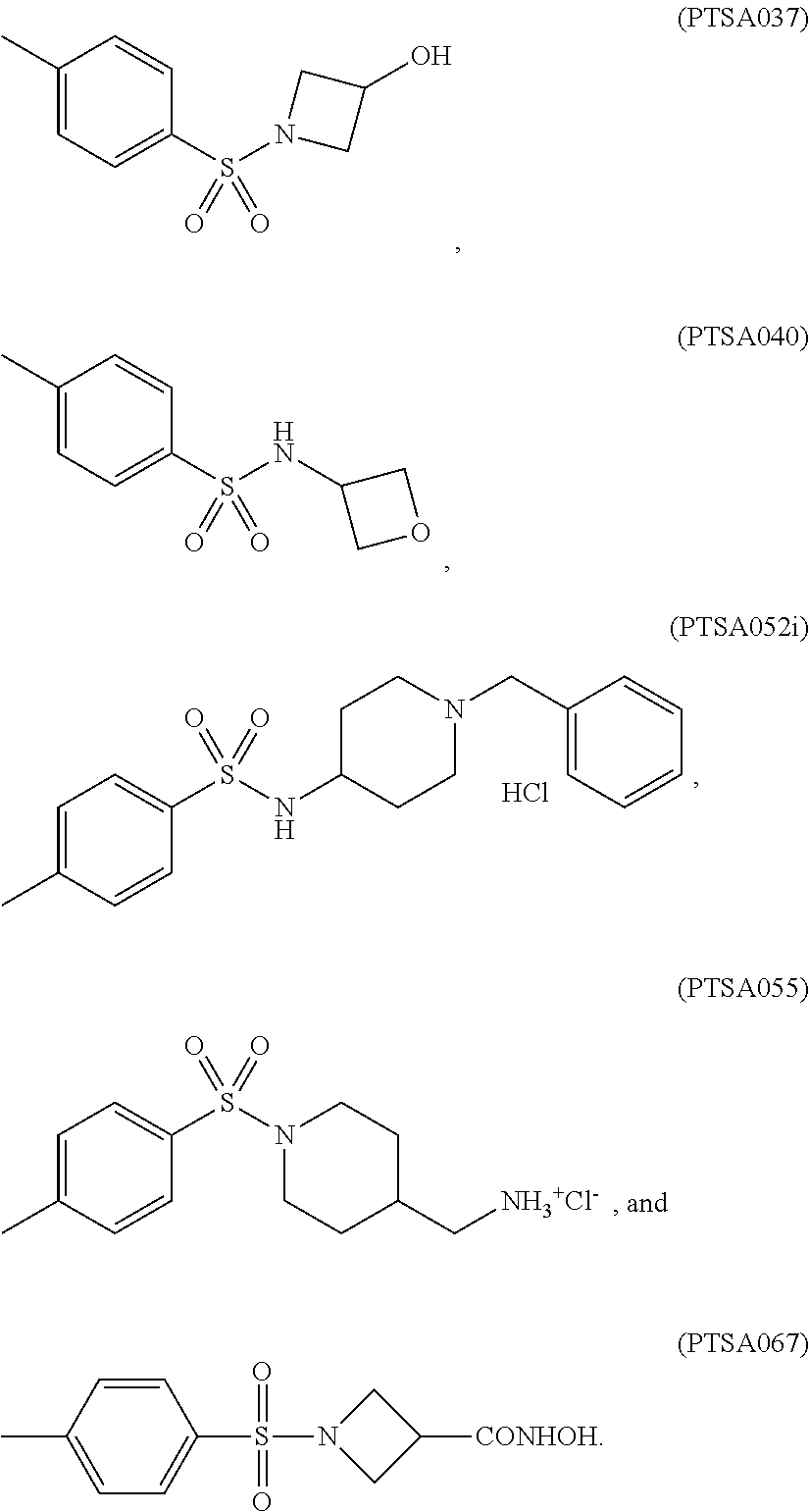
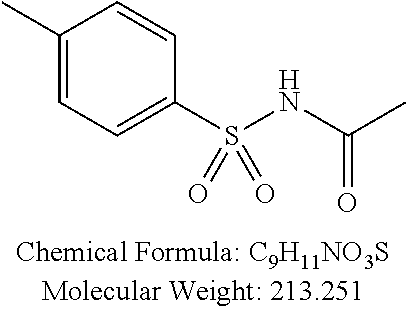
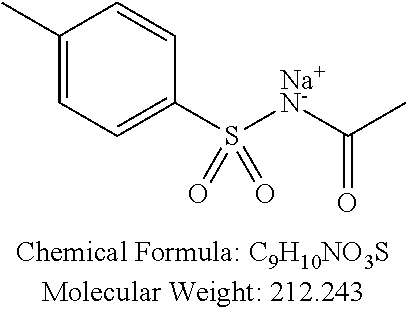

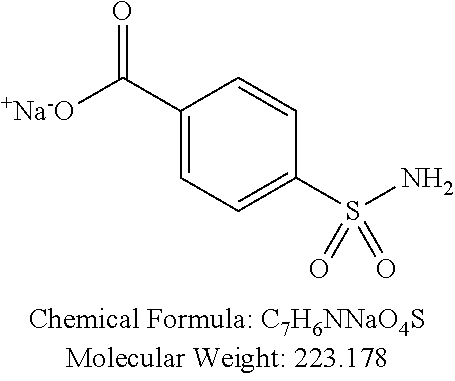
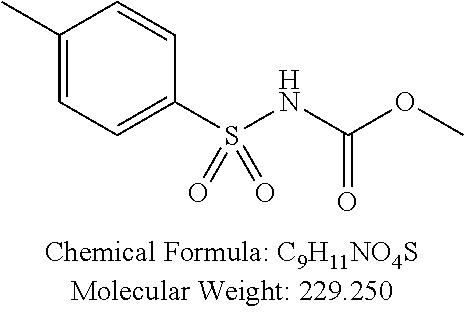
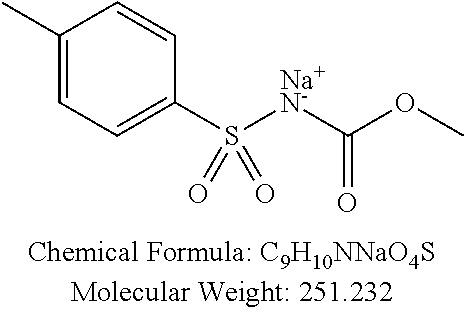

View All Diagrams
| United States Patent | 10,485,773 |
| Yang , et al. | November 26, 2019 |
Benzenesulfonamide derivatives and method for treating cancer
Abstract
Provided are benzenesulfonamide derivatives or pharmaceutically acceptable salts thereof. Also provided is a method for treating cancer by using a pharmaceutical composition including the benzenesulfonamide derivatives or pharmaceutically acceptable salts thereof and pharmaceutically acceptable carriers.
| Inventors: | Yang; Chuan-Ching (Taipei, TW), Wu; Shun-Chi (Taipei, TW), Zhong; Nanshan (Taipei, TW), Lin; Mao-Yuan (Taipei, TW), Tu; Chi-Chiang (Taipei, TW), Lee; On (Taipei, TW) | ||||||||||
|---|---|---|---|---|---|---|---|---|---|---|---|
| Applicant: |
|
||||||||||
| Assignee: | GONGWIN BIOPHARM HOLDINGS CO.,
LTD. (Grand Cayman, KY) |
||||||||||
| Family ID: | 59065347 | ||||||||||
| Appl. No.: | 16/014,295 | ||||||||||
| Filed: | June 21, 2018 |
Prior Publication Data
| Document Identifier | Publication Date | |
|---|---|---|
| US 20180311190 A1 | Nov 1, 2018 | |
Related U.S. Patent Documents
| Application Number | Filing Date | Patent Number | Issue Date | ||
|---|---|---|---|---|---|
| PCT/US2017/067048 | Dec 18, 2017 | ||||
| 15387221 | Oct 10, 2017 | 9782370 | |||
| Current U.S. Class: | 1/1 |
| Current CPC Class: | A61K 47/12 (20130101); C07D 305/08 (20130101); A61K 47/10 (20130101); A61K 31/397 (20130101); A61K 9/0019 (20130101); A61K 31/337 (20130101); A61K 9/0021 (20130101); A61K 31/4468 (20130101); A61K 47/20 (20130101); A61K 31/18 (20130101); A61P 35/00 (20180101) |
| Current International Class: | A61K 31/18 (20060101); C07D 305/08 (20060101); A61K 31/4468 (20060101); A61K 31/397 (20060101); A61K 31/337 (20060101); A61P 35/00 (20060101); A61K 9/00 (20060101); A61K 47/20 (20060101); A61K 47/10 (20170101); A61K 47/12 (20060101) |
References Cited [Referenced By]
U.S. Patent Documents
| 9782370 | October 2017 | Yang |
Other References
|
Powell et al., Journal of Organic Chemistry (2010), 75(8), pp. 2726-2729. cited by examiner. |
Primary Examiner: Davis; Brian J
Attorney, Agent or Firm: Kramer Amado, P.C.
Parent Case Text
CROSS-REFERENCE TO RELATED APPLICATIONS
This application is a continuation-in-part of PCT/US2017/067048 filed on Dec. 18, 2017, which is a continuation of Ser. No. 15/387,221, filed on Dec. 21, 2016, now issued as U.S. Pat. No. 9,782,370. The entire disclosures of the prior applications are hereby incorporated by reference herein in their entirety.
Claims
What is claimed is:
1. A benzenesulfonamide derivative represented by formula (I) or a pharmaceutically acceptable salt thereof: ##STR00067## wherein: R.sub.1, R.sub.2, R.sub.4 and R.sub.5 are H; R.sub.3 is a methyl group; and R.sub.6 and R.sub.7 are independently selected from the group consisting of H and an unsubstituted or substituted C.sub.3-C.sub.6 cycloheteroalkyl group, provided that R.sub.6 and R.sub.7 are not H at the same time, and wherein the benzenesulfonamide derivative is ##STR00068##
2. A method for treating cancer in a subject in need thereof, comprising administering a therapeutically effective amount of a pharmaceutical composition to the subject, wherein the pharmaceutical composition comprises the benzenesulfonamide derivative or the pharmaceutically acceptable salt thereof of claim 1, and a pharmaceutically acceptable carrier.
3. The method of claim 2, wherein the pharmaceutically acceptable carrier is selected from the group consisting of a filler, a binder, a preservative, a disintegrating agent, a lubricant, a suspending agent, a wetting agent, a solvent, a surfactant, an acid, a flavoring agent, polyethylene glycol (PEG), alkylene glycol, sebacic acid, dimethyl sulfoxide (DMSO), alcohol and a combination thereof.
4. The method of claim 2, wherein the benzenesulfonamide derivative or the pharmaceutically acceptable salt thereof is present in the pharmaceutical composition in an amount of from 0.10% to 50% by weight.
5. The method of claim 2, wherein the benzenesulfonamide derivative or the pharmaceutically acceptable salt thereof is present in the pharmaceutical composition in an amount of from 1% to 40% by weight.
6. The method of claim 2, wherein the pharmaceutical composition is administered to the subject intratumorally, intravenously, subcutaneously, intradermally, intrathecally, intraperitoneally, intramuscularly, or intrapleuraly.
7. The method of claim 2, wherein the cancer is at least one selected from the group consisting of liver cancer, lung cancer, breast cancer, head and neck cancer, colon cancer, renal cancer, skin cancer, cervical cancer, prostate cancer, pancreatic cancer and gastric cancer.
8. The method of claim 7, wherein the cancer is liver cancer or lung cancer.
Description
BACKGROUND
1. Technical Field
The present disclosure relates to benzenesulfonamide derivatives or pharmaceutically acceptable salts thereof. The present disclosure also relates methods for treating cancer in a subject by administering a pharmaceutical composition containing the benzenesulfonamide derivatives or pharmaceutically acceptable salts thereof.
2. Description of Related Art
Toluene sulfonamide is known as an effective anti-fungal agent and used to treat plant and animal (e.g., human) tissues infected with a fungus. U.S. Pat. Nos. 5,891,454 and 6,727,287 both disclose a toluene sulfonamide-containing composition that exhibits anti-cancer and anti-tumor necrotizing activity.
However, there still remains an unmet need to provide an injectable composition for the more effective and safer treatment of cancer.
SUMMARY
In view of the foregoing, the present disclosure provides a benzenesulfonamide derivative represented by formula (I) or a pharmaceutically acceptable salt thereof:
##STR00001## wherein:
R.sub.1, R.sub.2, R.sub.4 and R.sub.5 are H;
R.sub.3 is a methyl group;
R.sub.6 and R.sub.7 are independently selected from the group consisting of H, an unsubstituted or substituted C.sub.3-C.sub.6 cycloalkyl group and an unsubstituted or substituted C.sub.3-C.sub.6 cycloheteroalkyl group, or R.sub.6 and R.sub.7 are linked to each other to form an unsubstituted or substituted ring, provided that R.sub.6 and R.sub.7 are not H at the same time.
The present disclosure also provides a method for treating cancer in a subject in need thereof, comprising administering a therapeutically effective amount of a pharmaceutical composition to the subject, wherein the pharmaceutical composition comprises a benzenesulfonamide derivative represented by formula (I) or a pharmaceutically acceptable salt thereof, and a pharmaceutically acceptable carrier.
DETAILED DESCRIPTION OF THE EMBODIMENTS
The following examples are used to exemplify the present disclosure. A person of ordinary skills in the art can understand the other advantages of the present disclosure, based on the specification of the present disclosure. The present disclosure can also be implemented or applied as described in different specific examples. It is possible to modify or alter the examples for carrying out this disclosure without contravening its spirit and scope for different aspects and applications.
It is further noted that, as used in this specification, the singular forms "a," "an," and "the" include plural referents unless expressly and unequivocally limited to one referent. The term "or" is used interchangeably with the term "and/or" unless the context clearly indicates otherwise.
As used herein, the term "soluble" means that powder of a benzenesulfonamide derivative or a pharmaceutically acceptable salt thereof does not precipitate in solvents such as dimethyl sulfoxide (DMSO) or water but forms a transparent and clear solution or a non-transparent but uniform solution.
The present disclosure provides a benzenesulfonamide derivative represented by formula (I) or a pharmaceutically acceptable salt thereof:
##STR00002## wherein:
R.sub.1, R.sub.2, R.sub.4 and R.sub.5 are independently H;
R.sub.3 is a methyl group or a carboxyl group;
R.sub.6 and R.sub.7 are independently selected from the group consisting of H, an unsubstituted or substituted C.sub.3-C.sub.6 cycloalkyl group and an unsubstituted or substituted C.sub.3-C.sub.6 cycloheteroalkyl group, or R.sub.6 and R.sub.7 are linked to each other to form an unsubstituted or substituted ring, provided that R.sub.6 and R.sub.7 are not H at the same time.
In an embodiment of the present disclosure, the substituted cycloalkyl group, the substituted cycloheteroalkyl group and the substituted ring are independently substituted with a substituent selected from the group consisting of an amide group, a hydroxyl group, a benzyl group and an aminomethyl group. In another embodiment of the present disclosure, the substituent may be further substituted with another substituent.
In an embodiment of the present disclosure, the benezesulfonamide derivative or the pharmaceutically acceptable salt thereof is selected from the group consisting of
##STR00003##
The present disclosure also provides a method for treating cancer in a subject in need thereof, comprising administering a therapeutically effective amount of a pharmaceutical composition to the subject, wherein the pharmaceutical composition comprises a benzenesulfonamide derivative or a pharmaceutically acceptable salt thereof, and a pharmaceutically acceptable carrier.
In an embodiment of the present disclosure, the benzenesulfonamide derivative is represented by formula (I):
##STR00004## or a pharmaceutically acceptable salt thereof,
wherein:
R.sub.1, R.sub.2, R.sub.4 and R.sub.5 are independently H;
R.sub.3 is a methyl group or a carboxyl group;
R.sub.6 and R.sub.7 are independently selected from the group consisting of H, an unsubstituted or substituted C.sub.3-C.sub.6 cycloalkyl group and an unsubstituted or substituted C.sub.3-C.sub.6 cycloheteroalkyl group, or R.sub.6 and R.sub.7 are linked to each other to form an unsubstituted or substituted ring, provided that R.sub.6 and R.sub.7 are not H at the same time.
In an embodiment of the present disclosure, the substituted cycloalkyl group, the substituted cycloheteroalkyl group and the substituted ring are independently substituted with a substituent selected from the group consisting of an amide group, a hydroxyl group, a benzyl group and an aminomethyl group.
In an embodiment of the present disclosure, R.sub.6 and R.sub.7 of the benzenesulfonamide derivative represented by formula (I) are linked to each other to form an unsubstituted or substituted 4- to 6-membered ring, wherein the substituted ring is substituted with a substituent selected from the group consisting of an amide group, a hydroxyl group, a benzyl group and an aminomethyl group. In another embodiment of the present disclosure, R.sub.6 and R.sub.7 of the benzenesulfonamide derivative represented by formula (I) are independently selected from the group consisting of H, an unsubstituted or substituted C.sub.3-C.sub.6 cycloalkyl group and an unsubstituted or substituted C.sub.3-C.sub.6 cycloheteroalkyl group, provided that R.sub.6 and R.sub.7 are not H at the same time, wherein the substituted cycloalkyl group and the substituted cycloheteroalkyl group are independently substituted with a substituent selected from the group consisting of an amide group, a hydroxyl group, a benzyl group and an aminomethyl group.
In an embodiment of the present disclosure, the benezesulfonamide derivative or the pharmaceutically acceptable salt thereof is selected from the group consisting of
##STR00005##
In an embodiment of the present disclosure, the pharmaceutically acceptable carrier is selected from the group consisting of a filler, a binder, a preservative, a disintegrating agent, a lubricant, a suspending agent, a wetting agent, a solvent, a surfactant, an acid, a flavoring agent, polyethylene glycol (PEG), alkylene glycol, sebacic acid, dimethyl sulfoxide (DMSO), alcohol and a combination thereof.
In an embodiment of the present disclosure, the benzenesulfonamide derivative or the pharmaceutically acceptable salt thereof is present in the pharmaceutical composition in an amount of from 0.1% to 50% of the composition by weight. For example, an amount of the benzenesulfonamide derivative or the pharmaceutically acceptable salt thereof in the pharmaceutical composition has a lower limit chosen from 0.1%, 0.2%, 0.5%, 1%, 2.5%, 5%, 10%, 15%, 20%, 25% and 30% of the composition by weight, and an upper limit chosen from 50%, 45%, 40%, 35% and 30% of the composition by weight.
In an embodiment of the present disclosure, the cancer may be at least one selected from the group consisting of liver cancer, lung cancer, breast cancer, head and neck cancer, colon cancer, renal cancer, skin cancer, cervical cancer, prostate cancer, pancreatic cancer and gastric cancer. In another embodiment of the present disclosure, the cancer is liver cancer or lung cancer.
The following are specific embodiments further demonstrating the efficacy of the current disclosure, but not to limit the scope of the current disclosure.
EXAMPLES
Example 1: Preparation of p-TSA Derivatives
Sixty one p-TSA derivatives as shown in Table 1 were chemically synthesized by ligating a functional group to the amino group of p-TSA, while at least one of the --NH groups was remained in the p-TSA derivatives, allowing the solubility of the p-TSA derivatives to be increased. Such derivatives can be divided into 8 major groups based on the characteristics of their functional groups. The first group of the p-TSA derivatives belongs to p-TSA metabolites and the salt thereof. The second group of the p-TSA derivatives belongs to acidic derivatives as being p-TSA prodrugs, wherein a strong electron-withdrawing group was ligated to the amino group of p-TSA, allowing the --NH group of p-TSA to be acidic to form a salt. The third group of the p-TSA derivatives belongs to the amino alcohol group, wherein the p-TSA derivatives with the hydroxyl group were formed by reacting p-toluenesulfonyl chloride with an amino alcohol, and the hydroxyl group of the p-TSA derivatives allows the solubility thereof to be increased. The fourth group of the p-TSA derivatives belongs to the amino ether group, wherein the p-TSA derivatives with the ether group were formed by reacting p-toluenesulfonyl chloride with an amino ether, and the ether group of the p-TSA derivatives allows the solubility thereof to be increased. The fifth group of the p-TSA derivatives belongs to the amino acid group, wherein the p-TSA derivatives with the carboxyl group were formed by reacting p-toluenesulfonyl chloride with an amino acid, and the carboxyl group of the p-TSA derivatives allows the solubility thereof to be increased and the salts thereof to be formed. The sixth group of the p-TSA derivatives belongs to the fluoroamine group, wherein the p-TSA derivatives with the fluoro group were formed by reacting p-toluenesulfonyl chloride with the fluoro group of amines, and the fluoro group of the p-TSA derivatives provides the p-TSA derivatives with specific bioactivity. The seventh group of the p-TSA derivatives belongs to the amino amine group, wherein the p-TSA derivatives with the additional amine group (R--N HCl) were formed by reacting p-toluenesulfonyl chloride with a tertiary amine, and the additional amine group of the p-TSA derivatives allows the solubility thereof to be increased and the salts thereof to be formed. The eighth group of the p-TSA derivatives belongs to the azetidine derivatives of PTSA037 as shown in Table 1, wherein the azetidine derivatives of PTSA037 have better solubility than PTSA037. Each of the p-TSA derivatives has purity greater than 90%.
TABLE-US-00001 TABLE 1 p-TSA derivatives Groups of Chemical structure, formula and p-TSA derivatives Number molecular weight p-TSA metabolites and the salts thereof PTSA001 ##STR00006## PTSA002 ##STR00007## PTSA004 ##STR00008## PTSA005 ##STR00009## Acidic derivatives PTSA011 ##STR00010## PTSA012 ##STR00011## PTSA014 ##STR00012## PTSA015 ##STR00013## PTSA017 ##STR00014## PTSA018 ##STR00015## Amino alcohols PTSA020 ##STR00016## PTSA021 ##STR00017## PTSA022 ##STR00018## PTSA023 ##STR00019## PTSA024 ##STR00020## PTSA025 ##STR00021## PTSA026 ##STR00022## PTSA027 ##STR00023## PTSA028 ##STR00024## PTSA029 ##STR00025## PTSA030 ##STR00026## PTSA031 ##STR00027## PTSA032 ##STR00028## PTSA033 ##STR00029## PTSA034 ##STR00030## PTSA035 ##STR00031## PTSA036 ##STR00032## PTSA037 ##STR00033## Amino ethers PTSA039 ##STR00034## PTSA040 ##STR00035## PTSA041 ##STR00036## PTSA042 ##STR00037## PTSA043 ##STR00038## Amino acids PTSA044 ##STR00039## PTSA045 ##STR00040## PTSA046 ##STR00041## PTSA047 ##STR00042## PTSA048 ##STR00043## Fluoroamines PTSA049 ##STR00044## PTSA050 ##STR00045## Amino amines PTSA051 ##STR00046## PTSA052 ##STR00047## PTSA052i ##STR00048## PTSA053 ##STR00049## PTSA054 ##STR00050## PTSA055 ##STR00051## PTSA038 ##STR00052## Azetidine derivatives of PTSA037 PTSA061 ##STR00053## PTSA062 ##STR00054## PTSA063 ##STR00055## PTSA064 ##STR00056## PTSA065 ##STR00057## PTSA066 ##STR00058## PTSA067 ##STR00059## PTSA068 ##STR00060## PTSA069 ##STR00061## PTSA070 ##STR00062## PTSA071 ##STR00063## PTSA072 ##STR00064## PTSA073 ##STR00065## PTSA074 ##STR00066##
Example 2: Solubility of the p-TSA Derivatives
Table 2 shows the amounts of each of the p-TSA derivatives for preparing a 3 M solution in DMSO or water. Each of the powder of p-TSA derivatives was duplicated, placed in each 15 mL centrifuge tube, followed by adding 200 .mu.L DMSO or 200 .mu.L water and shaking for 10 to 20 seconds for dissolution observation. If the powder was not dissolved, additional DMSO or water was added, and then the mixture was shaken. The tube was left to stand for 10 minutes for observation if the powder was still not dissolved after adding 1 mL DMSO or 1 mL water. If the powder was still not dissolved after adding 5 mL DMSO or 5 mL water, additional 1 mL DMSO or 1 mL water was added, and then the mixture was shaken for 30 seconds. If the powder was still not dissolved after adding 10 mL DMSO or 10 mL water, the tube was left to stand for 12 to 16 hours and observed on the next day. DMSO or water was added into the tube having the undissolved p-TSA derivatives up to 15 mL, followed by shaking for 30 minutes for observation.
A second dissolution test was performed for the undissolved p-TSA derivatives. Each of 100 mg p-TSA derivatives powder was placed in each of the scintillation vial, followed by adding 500 .mu.L DMSO or 500 .mu.L water and shaking for 30 seconds for dissolution observation. If the powder was not dissolved, additional DMSO or water was added, followed by shaking. The tube was left to stand for 10 minutes if the powder was still not dissolved after adding 1 mL DMSO or 1 mL water.
TABLE-US-00002 TABLE 2 Amounts of p-TSA derivatives for solubility test p-TSA Molecular Amounts for preparing 3M derivatives weight solution in 0.5 mL DMSO or water (g) PTSA001 213.251 0.3198765 PTSA002 212.243 0.3183645 PTSA004 201.196 0.301794 PTSA005 223.178 0.334767 PTSA011 229.25 0.343875 PTSA012 251.232 0.376848 PTSA014 243.277 0.3649155 PTSA015 265.259 0.3978885 PTSA017 368.422 0.552633 PTSA018 390.404 0.585606 PTSA020 215.267 0.3229005 PTSA021 229.294 0.343941 PTSA022 259.32 0.38898 PTSA023 229.294 0.343941 PTSA024 229.294 0.343941 PTSA025 229.294 0.343941 PTSA026 229.294 0.343941 PTSA027 245.293 0.3679395 PTSA028 245.293 0.3679395 PTSA029 245.293 0.3679395 PTSA030 259.32 0.38898 PTSA031 275.319 0.4129785 PTSA032 255.332 0.382998 PTSA033 255.332 0.382998 PTSA034 255.332 0.382998 PTSA035 241.305 0.3619575 PTSA036 241.305 0.3619575 PTSA037 335.371 0.5030565 PTSA038 255.332 0.382998 PTSA039 271.331 0.4069965 PTSA040 241.305 0.3619575 PTSA041 253.316 0.379974 PTSA042 229.294 0.343941 PTSA043 243.321 0.3649815 PTSA044 229.25 0.343875 PTSA045 243.277 0.3649155 PTSA046 259.276 0.388914 PTSA047 390.451 0.5856765 PTSA048 279.325 0.4189875 PTSA049 217.258 0.325887 PTSA050 253.239 0.3798585 PTSA051 278.795 0.4181925 PTSA052 290.806 0.436209 PTSA052i 380.93 0.571395 PTSA053 290.806 0.436209 PTSA054 304.833 0.4572495 PTSA055 304.833 0.4572495 PTSA061 277.27 0.415905 PTSA062 254.3 0.38145 PTSA063 236.29 0.354435 PTSA064 247.26 0.37089 PTSA065 229.27 0.343905 PTSA066 225.26 0.33789 PTSA067 270.3 0.40545 PTSA068 276.78 0.41517 PTSA069 241.31 0.361965 PTSA070 240.28 0.36042 PTSA071 269.32 0.40398 PTSA072 254.3 0.38145 PTSA073 476.57 0.714855 PTSA074 262.75 0.394125
Results were shown in Table 3 below, demonstrating that: fifteen p-TSA derivatives were dissolved in both of DMSO and water; forty-four p-TSA derivatives were dissolved only in DMSO; one p-TSA derivative was dissolved only in water; and one p-TSA derivative was undissolved in both of DMSO and water.
TABLE-US-00003 TABLE 3 Dissolution of p-TSA derivatives Dissolved in Undissolved in both DMSO Dissolved only Dissolved only both DMSO and and water in DMSO in water water p-TSA PTSA002* PTSA001 and PTSA005 metabolites and PTSA004 the salts thereof Acidic PTSA012, PTSA011, derivatives PTSA015, and PTSA014, and (p-TSA PTSA018 PTSA017 prodrugs) Amino alcohol PTSA020 and PTSA021, PTSA032 (R-OH) PTSA031 PTSA022, PTSA023, PTSA024, PTSA025 PTSA026, PTSA027, PTSA028, PTSA029, PTSA030, PTSA033, PTSA034, PTSA035, PTSA036, and PTSA037 Amino ether PTSA039, (R-O) PTSA040, PTSA041, PTSA042, and PTSA043 Amino acids PTSA047 and PTSA044, (R-COOH) PTSA048 PTSA045, and PTSA046 Fluoroamines PTSA049*, and (R-F) PTSA050 Amino amines PTSA051, PTSA052i, (R-N HCl) PTSA052, PTSA054, and PTSA053, and PTSA038 PTSA055 PTSA037 PTSA061, PTSA062 derivatives PTSA068, and PTSA063, PTSA074 PTSA064, PTSA065, PTSA066, PTSA067, PTSA069, PTSA070, PTSA071, PTSA072, and PTSA073* *PTSA002, PTSA049 and PTSA073 were not dissolved in DMSO or water in the first dissolution test, but dissolved in DMSO, water or both in the second dissolution test.
As mentioned above, among the sixty-one p-TSA derivatives, except PTSA032 that was not dissolved in neither DMSO nor water, sixty p-TSA derivatives were found soluble in DMSO, whereas only sixteen p-TSA derivatives (including PTSA005) were soluble in water. It could be seen that only about 27% of the tested p-TSA derivatives was soluble in water.
Further, as shown in Tables 4 to 6 below, by comparison with the solubility of p-TSA, it was found that the hydrophilic functional groups ligated to the p-TSA derivatives did not necessarily enhance the solubility thereof.
TABLE-US-00004 TABLE 4 Solubility of p-TSA derivatives Amounts for Total volume preparing a 3M Total volume of of water solution in DMSO for dissolving for dissolving the p-TSA 0.5 mL DMSO the p-TSA derivatives p-TSA derivatives derivatives or water (g) (.mu.L) (.mu.L) PTSA001 0.3198765 510 insoluble in 15000 PTSA002 0.3183645 insoluble in 15000 insoluble in 15000 PTSA004 0.301794 960 (with pipetting) insoluble in 15000 PTSA005 0.334767 insoluble in 15000 10000 PTSA011 0.343875 560 insoluble in 15000 PTSA012 0.376848 680 500 PTSA014 0.3649155 610 insoluble in 15000 PTSA015 0.3978885 815 500 PTSA017 0.552633 2000 insoluble in 15000 PTSA018 0.585606 2000 2500 PTSA020 0.3229005 490 10000 PTSA021 0.343941 495 insoluble in 15000 PTSA022 0.38898 505 insoluble in 15000 PTSA023 0.343941 500 insoluble in 15000 PTSA024 0.343941 515 insoluble in 15000 PTSA025 0.343941 560 insoluble in 15000 PTSA026 0.343941 500 insoluble in 15000 PTSA027 0.3679395 575 insoluble in 15000 PTSA028 0.3679395 620 insoluble in 15000 PTSA029 0.3679395 500 insoluble in 15000 PTSA030 0.38898 695 insoluble in 15000 PTSA031 0.4129785 700 10000 PTSA032 0.382998 insoluble in 15000 insoluble in 15000 PTSA033 0.382998 500 insoluble in 15000 PTSA034 0.382998 505 insoluble in 15000 PTSA035 0.3619575 490 insoluble in 15000 PTSA036 0.3619575 530 insoluble in 15000 PTSA037 0.5030565 605 insoluble in 15000 PTSA038 0.382998 680 insoluble in 15000 PTSA039 0.4069965 500 insoluble in 15000 PTSA040 0.3619575 475 insoluble in 15000 PTSA041 0.379974 4000 insoluble in 15000 PTSA042 0.343941 475 insoluble in 15000 PTSA043 0.3649815 505 insoluble in 15000 PTSA044 0.343875 600 insoluble in 15000 PTSA045 0.3649155 2000 insoluble in 15000 PTSA046 0.388914 845 insoluble in 15000 PTSA047 0.5856765 2000 2500 PTSA048 0.4189875 2000 10000 PTSA049 0.325887 insoluble in 15000 insoluble in 15000 PTSA050 0.3798585 590 insoluble in 15000 PTSA051 0.4181925 1500 1000 PTSA052 0.436209 2000 5000 PTSA052i 0.571395 4000 insoluble in 15000 PTSA053 0.436209 15000 2500 PTSA054 0.4572495 740 insoluble in 15000 PTSA055 0.4572495 2000 3000 PTSA061 0.415905 2500 750 PTSA062 0.38145 3000 insoluble in 15000 PTSA063 0.354435 900 insoluble in 15000 PTSA064 0.37089 750 insoluble in 15000 PTSA065 0.343905 2500 insoluble in 15000 PTSA066 0.33789 3000 insoluble in 15000 PTSA067 0.40545 870 insoluble in 15000 PTSA068 0.41517 4000 4500 PTSA069 0.361965 880 insoluble in 15000 PTSA070 0.36042 850 insoluble in 15000 PTSA071 0.40398 1500 insoluble in 15000 PTSA072 0.38145 4500 insoluble in 15000 PTSA073 0.714855 insoluble in 15000 insoluble in 15000 PTSA074 0.394125 2500 10000
TABLE-US-00005 TABLE 5 Comparison of solubility of p-TSA and p-TSA derivatives in DMSO and water p-TSA and p-TSA Solubility in DMSO Solubility in water derivatives (mg/mL) (mg/mL) PTSA 785.95 <50 PTSA037 831.50 <50 PTSA040 762.02 <50 PTSA052i 142.85 <50 PTSA055 228.62 152.42 PTSA067 466.03 <50
As shown in Table 6 below, the powder of PTSA002, PTSA049 and PTSA073 were not dissolved in DMSO or water in the first dissolution test, but dissolved in both of
DMSO or water in the second dissolution test by use of less (100 mg) powder for dissolving in a larger volume (500 .mu.L) of DMSO or water. Further, the powder of PTSA0032 was still not dissolved in 20 mL DMSO or 20 mL water, and was considered as being undissolved in the desired concentration.
TABLE-US-00006 TABLE 6 Solubility of p-TSA derivatives in the second dissolution test p-TSA Total volume of Total volume of water derivatives for DMSO for dissolving for dissolving the the second Amount the p-TSA derivatives p-TSA derivatives dissolution test (g) (mL) (mL) PTSA002 0.1 8 5.25 PTSA032 0.1 insoluble in 20 ml insoluble in 20 mL PTSA049 0.1 9.5 insoluble in 20 mL PTSA073 0.1 4.04 insoluble in 20 mL
Example 3: Effect of the p-TSA Derivatives on Killing Liver and Lung Cancer Cells
Human non-small-cell lung cancer cell lines H460 in an amount of 5.times.10.sup.3 cells/well or human liver cancer cell lines Hep3B in an amount of 4.times.10.sup.3 cells/well was respectively seeded in each well of a 96-well plate and incubated under the condition of 5% CO.sub.2 at 37.degree. C. for 24 hours. Further, 25 .mu.L trichloroacetic acid (TCA) was added into each well for fixing cells. After letting to stand for 10 minutes at room temperature, the supernatant of each well was removed, and each well was washed with 200 .mu.L H.sub.2O once.
Each of the sixty p-TSA derivatives was added into each well in an indicated concentration, and incubated for 48 hours. If the p-TSA derivative was seriously precipitated in a tube during dilution, the tube would be left to stand for 5 to 10 minutes, and the supernatant of the tube would be used in this test. The control in this test was performed in the same procedure as described above, except for addition of the p-TSA derivatives.
Each of the plates was then placed in the laminar flow cabinet for 1 hour for air dry. 50 .mu.L 0.4% sulforhodamine B (SRB) dye was added into each well of the 96-well plate. After letting to stand at room temperature for 10 minutes, SRB dye was removed, and each well was washed with 200 .mu.L acetic acid at least one to three times until no dye residue was visually observed.
Each of the plates was then placed in the laminar flow cabinet for 40 minutes to 1 hour for air dry. 1.times.Tris-Base solution with pH 7.0 to 7.4 was added to each well of the 96-well plate to dissolve the protein complex formed in the bottom of each well, followed by tapping the 96-well plate, allowing the complex in each well to be dissolved uniformly. Absorption of each well under 515 nm was read. The half maximal inhibitory concentration (IC.sub.50) of each p-TSA derivative against human non-small-cell lung cancer cell lines H460 and human liver cancer cell lines Hep3B was calculated by the formula of: 1-([(Tx-Tz)/(Control-Tz)].times.100%), wherein Tz indicates the cell population at the time of each p-TSA derivative addition, and Tx indicates the cells treated with tested samples. Each of the experimental group was performed in triplet.
Results were shown in Table 7 below. For the effect on inhibiting human non-small-cell lung cancer cell lines H460, p-TSA dissolved in DMSO was used as a control, and has an IC.sub.50 value being 3.7191.+-.0.146 mM.
Results showed that PTSA037, PTSA040, PTSA052i, PTSA055 and PTSA067 surprisingly provided lower IC.sub.50 values than p-TSA about 6 to 20 folds, indicating better capacity for inhibiting the growth of lung cancer cells. Specifically, the IC.sub.50 values of PTSA037 dissolved in DMSO were 0.2877 mM and 0.2587 mM in the duplicated experiments; the IC.sub.50 values of PTSA040 dissolved in DMSO were 0.4311 mM and 0.4062 mM in the duplicated experiments; the IC.sub.50 value of PTSA052i dissolved in DMSO was 0.1414 mM; the IC.sub.50 value of PTSA055 dissolved in DMSO was 0.6174 mM; the IC.sub.50 value of PTSA055 dissolved in water was 0.6514 mM; and the IC.sub.50 value of PTSA067 dissolved in DMSO was 0.2733 mM. p-TSA derivatives other than PTSA037, PTSA040, PTSA052i, PTSA055 and PTSA067 either had higher IC.sub.50 values than that of p-TSA or provided lower IC.sub.50 values than that of p-TSA only 2 to 4 folds are not proceeded with further evaluation in this disclosure.
For the effect on inhibiting human liver cancer cell lines Hep3B, p-TSA dissolved in DMSO was used as a control group, and the IC.sub.50 value thereof was 3.7276.+-.0.274 mM.
Results showed that PTSA037, PTSA040, PTSA052i, PTSA055 and PTSA067 unexpectedly provided lower IC.sub.50 values than p-TSA about 6 to 20 folds, indicating better capacity for inhibiting the growth of liver cancer cells. Specifically, the IC.sub.50 values of PTSA037 dissolved in DMSO were 0.2647 mM and 0.2739 mM in the duplicated experiments; the IC.sub.50 values of PTSA040 dissolved in DMSO were 0.3287 mM and 0.4131 mM in the duplicated experiments; the IC.sub.50 value of PTSA052i dissolved in DMSO was 0.1369 mM; the IC.sub.50 value of PTSA055 dissolved in DMSO was 0.596 mM; the IC.sub.50 value of PTSA055 dissolved in water was 0.6102 mM; and the IC.sub.50 value of PTSA067 dissolved in DMSO was 0.2607 mM.
From the above, it could be seen that PTSA037, PTSA040, PTSA052i, PTSA055 and PTSA067 provided better effects on inhibiting the growth of human non-small-cell lung cancer cell lines H460 and human liver cancer cell lines Hep3B than that of p-TSA, and could be used as candidates for second-generation drug development.
TABLE-US-00007 TABLE 7 IC.sub.50 values of p-TSA and the derivatives thereof p-TSA IC.sub.50 of H460 in IC.sub.50 of H460 in IC.sub.50 of Hep3B in IC.sub.50 of Hep3B in derivatives water DMSO water DMSO p-TSA untested 3.7191 .+-. 0.146 mM untested 3.7276 .+-. 0.274 mM PTSA001 insoluble and not 7.7222 mM insoluble and not >9 mM able to be tested able to be tested PTSA002 >6.03 mM >0.27 mM >6.03 mM >0.27 mM PTSA004 insoluble and not 9.6724 mM insoluble and not >7 mM able to be tested able to be tested PTSA005 >2 mM insoluble and not >2 mM insoluble and not able to be tested able to be tested PTSA011 insoluble and not 5.4937 mM insoluble and not 4.561 mM able to be tested able to be tested PTSA012 >5 mM 6.1144 mM untested 7.5 mM PTSA014 insoluble and not 5.8175 mM insoluble and not 4.5943 mM able to be tested able to be tested PTSA015 4.9592 mM 4.7855 mM untested 5.7678 mM PTSA017 insoluble and not >3 mM insoluble and not >3 mM able to be tested able to be tested PTSA018 >3 mM >3 mM >3 mM >3 mM PTSA020 >1 mM 2.6103 mM >1 mM 2.645 mM PTSA021 insoluble and not 2.4481 mM insoluble and not 2.8143 mM able to be tested able to be tested PTSA022 insoluble and not 3.6535 mM insoluble and not 4.7235 mM able to be tested able to be tested PTSA023 insoluble and not 2.8949 mM insoluble and not 2.6543 mM able to be tested able to be tested PTSA024 insoluble and not 3.2201 mM insoluble and not 3.8283 mM able to be tested able to be tested PTSA025 insoluble and not 3.1453 mM insoluble and not 3.543 mM able to be tested able to be tested PTSA026 insoluble and not 3.251 mM insoluble and not 3.9204 mM able to be tested able to be tested PTSA027 insoluble and not 5.3454 mM insoluble and not 4.1022 mM able to be tested able to be tested PTSA028 insoluble and not 5.529 mM insoluble and not 5.3593 mM able to be tested able to be tested PTSA029 insoluble and not 1.9651 mM insoluble and not 3.0544 mM able to be tested able to be tested PTSA030 insoluble and not 3.3027 mM insoluble and not 4.3146 mM able to be tested able to be tested PTSA031 >1 mM 3.3068 mM >1 mM 4.2096 mM PTSA032 insoluble and not insoluble and not insoluble and not insoluble and not able to be tested able to be tested able to be tested able to be tested PTSA033 insoluble and not 1.4237 mM insoluble and not 1.7556 mM able to be tested able to be tested PTSA034 insoluble and not 1.497 mM insoluble and not 1.7844 mM able to be tested able to be tested PTSA035 insoluble and not 2.8288 mM insoluble and not 2.282 mM able to be tested able to be tested PTSA036 insoluble and not 2.5426 mM insoluble and not 3.403 mM able to be tested able to be tested PTSA037 insoluble and not 0.2877 mM; insoluble and not 0.2642 mM; able to be tested 0.2587 mM able to be tested 0.2739 mM PTSA038 insoluble and not 1.6177 mM insoluble and not 1.5695 mM able to be tested able to be tested PTSA039 insoluble and not 4.1571 mM insoluble and not 3.7395 mM able to be tested able to be tested PTSA040 insoluble and not 0.4311 mM; insoluble and not 0.3287 mM; able to be tested 0.4062 mM able to be tested 0.4131 mM PTSA041 insoluble and not >2 mM insoluble and not >2 mM able to be tested able to be tested PTSA042 insoluble and not 2.4911 mM insoluble and not 2.748 mM able to be tested able to be tested PTSA043 insoluble and not 1.6106 mM insoluble and not 1.8441 mM able to be tested able to be tested PTSA044 insoluble and not 7.9259 mM insoluble and not 9.1108 mM able to be tested able to be tested PTSA045 insoluble and not >3 mM insoluble and not >3 mM able to be tested able to be tested PTSA046 insoluble and not >10 mM insoluble and not >10 mM able to be tested able to be tested PTSA047 >3 mM >3 mM >3 mM >3 mM PTSA048 >3 mM >3 mM >3 mM >3 mM PTSA049 insoluble and not >0.174 mM insoluble and not >0.174 mM able to be tested able to be tested PTSA050 insoluble and not precipitated and insoluble and not precipitated and able to be tested not able to be able to be tested not able to be tested tested PTSA051 1.747 mM 1.8183 mM 1.4394 mM 1.4138 mM PTSA052 1.088 mM 0.9065 mM 0.9544 mM 0.919 mM PTSA052i insoluble and not 0.1414 mM insoluble and not 0.1369 mM able to be tested able to be tested PTSA053 0.6909 mM untested 0.7696 mM untested PTSA054 insoluble and not 1.1654 mM insoluble and not 0.9352 mM able to be tested able to be tested PTSA055 0.6514 mM 0.6174 mM 0.6102 mM 0.596 mM PTSA061 >8.8 mM >2.25 mM >8.8 mM >2.25 mM PTSA062 untested >2.25 mM untested >2.25 mM PTSA063 precipitated and 1.2695 mM precipitated and 1.296 mM not able to be not able to be tested tested PTSA064 emulsified and >0.713 mM emulsified and >0.713 mM not able to be not able to be tested tested PTSA065 precipitated and 1.3322 mM precipitated and 1.4471 mM not able to be not able to be tested tested PTSA066 precipitated and 0.906 mM precipitated and 0.733 mM not able to be not able to be tested tested PTSA067 untested 0.2733 mM untested 0.2607 mM PTSA068 1.3892 mM 1.2692 mM 1.2984 mM 1.2545 mM PTSA069 untested 2.5785 mM untested 3.6231 mM PTSA070 precipitated and precipitated and precipitated and precipitated and not able to be not able to be not able to be not able to be tested tested tested tested PTSA071 untested 1.0397 mM untested 1.0239 mM PTSA072 untested >1.125 mM untested >1.125 mM PTSA073 insoluble and not obviously misty insoluble and not obviously misty able to be tested and not able to be able to be tested and not able to be tested tested PTSA074 2.2152 mM >1.8 mM 2.1258 mM >1.8 mM
The disclosure has been described using exemplary embodiments. However, it is to be understood that the scope of the disclosure is not limited to the disclosed embodiments. On the contrary, it is intended to cover various modifications and similar rearrangements. The scope of the claims therefore should be accorded the broadest interpretation so as to encompass all such modifications and similar arrangements.
* * * * *
C00001

C00002

C00003

C00004

C00005

C00006

C00007

C00008

C00009

C00010

C00011

C00012

C00013
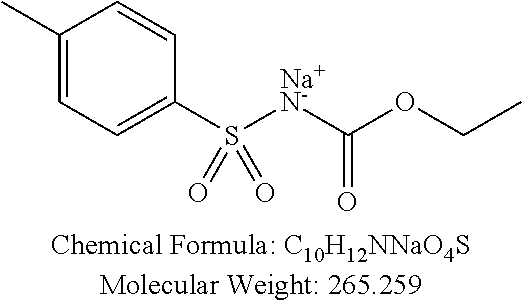
C00014

C00015
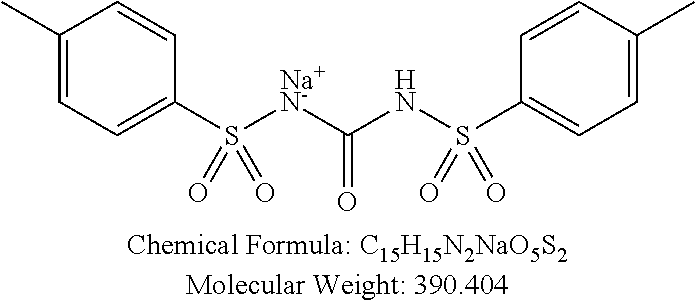
C00016

C00017

C00018
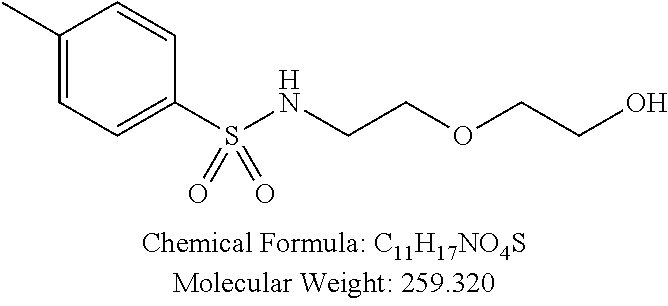
C00019

C00020

C00021
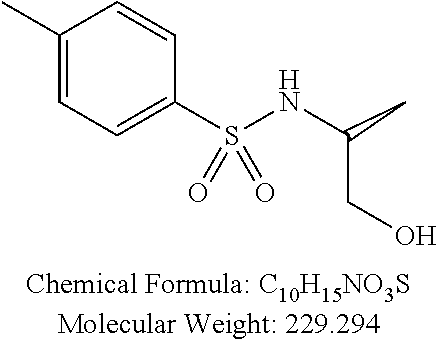
C00022
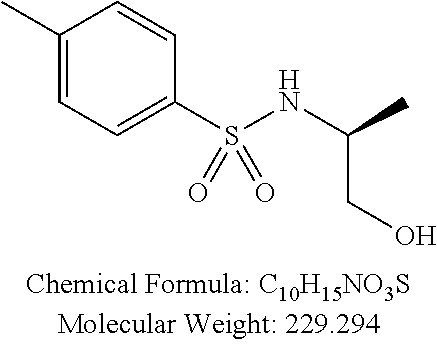
C00023

C00024

C00025
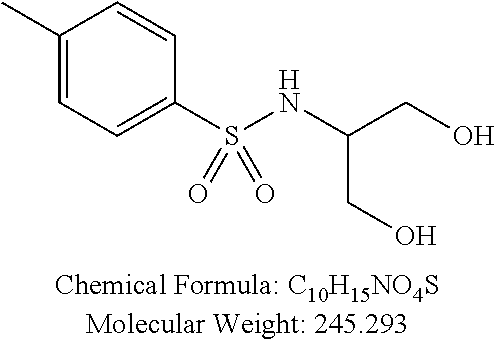
C00026
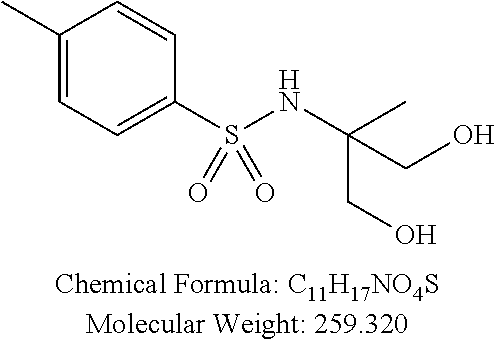
C00027

C00028
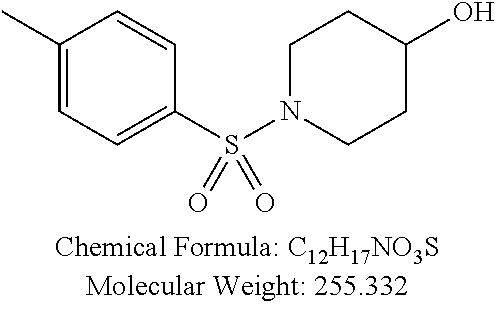
C00029
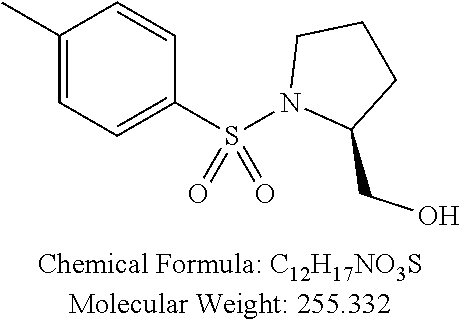
C00030
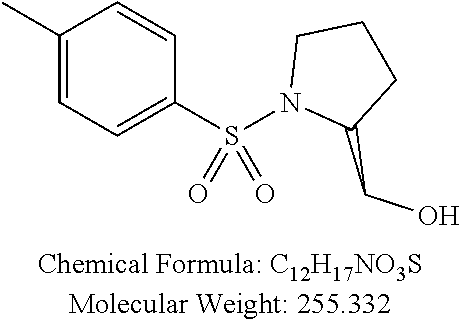
C00031

C00032

C00033
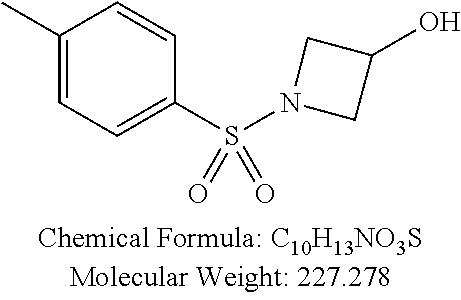
C00034

C00035
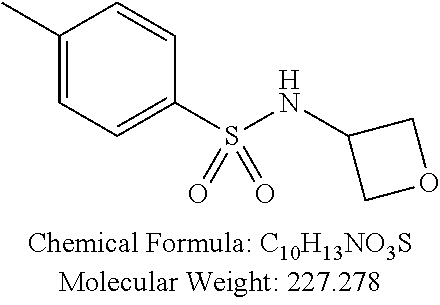
C00036

C00037

C00038
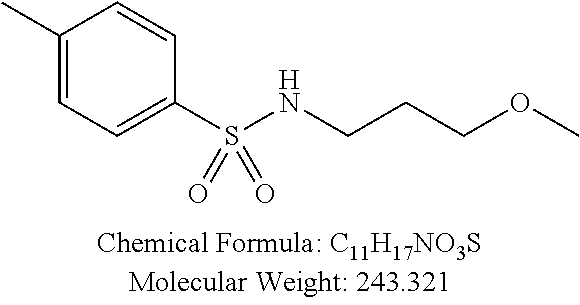
C00039
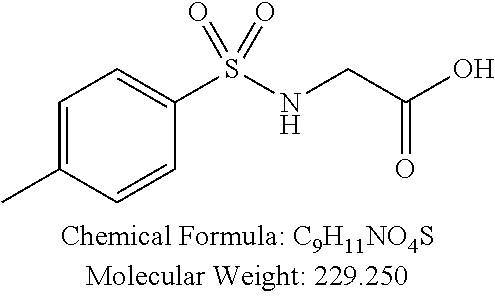
C00040
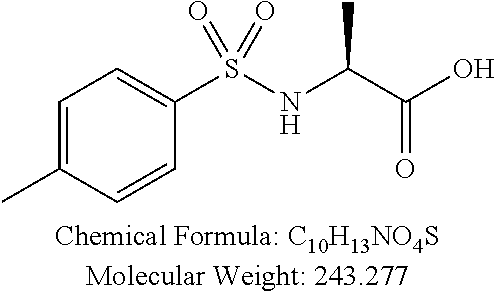
C00041
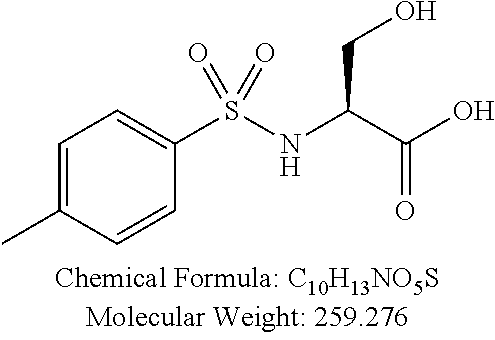
C00042

C00043
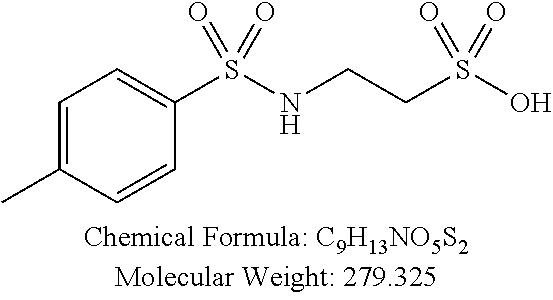
C00044
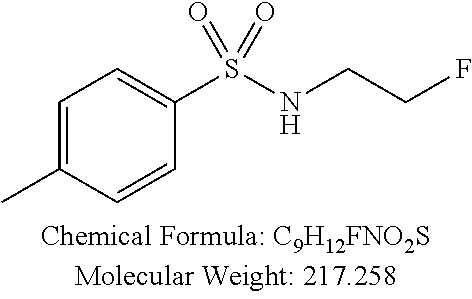
C00045

C00046
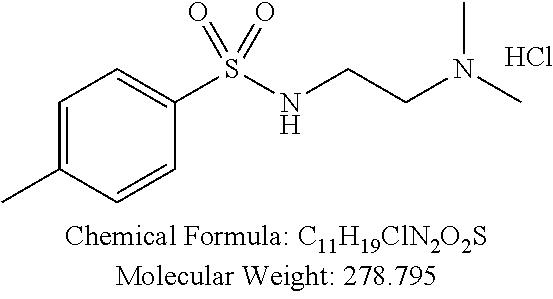
C00047

C00048

C00049

C00050
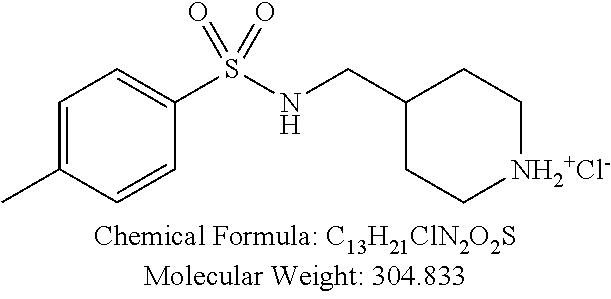
C00051

C00052
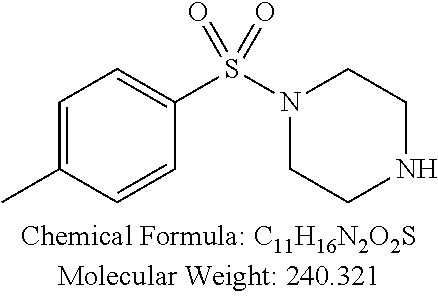
C00053
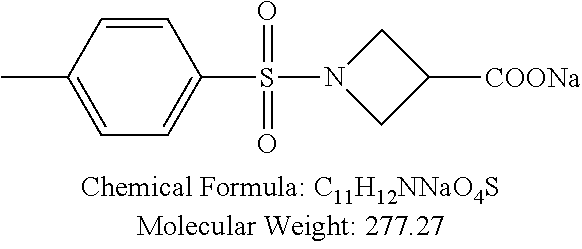
C00054
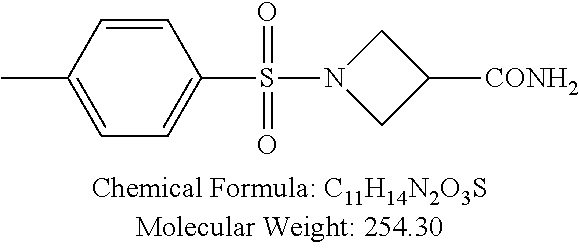
C00055
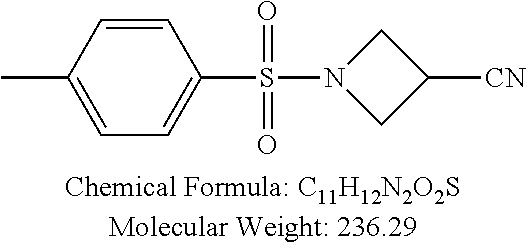
C00056
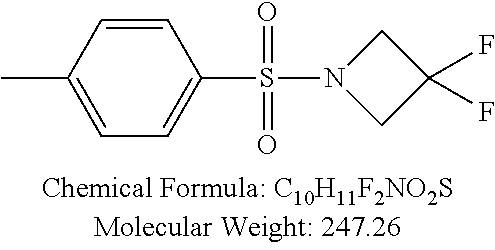
C00057
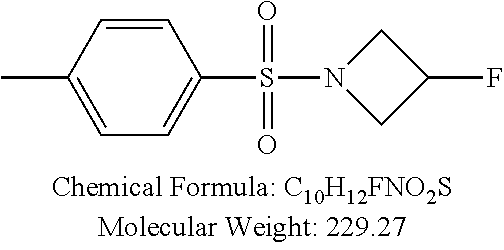
C00058

C00059
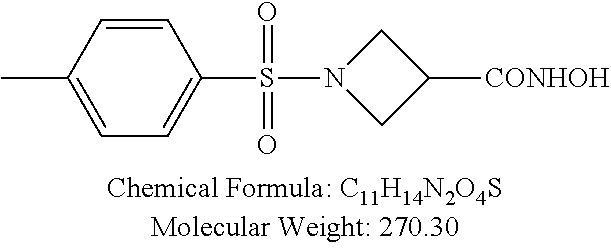
C00060

C00061

C00062
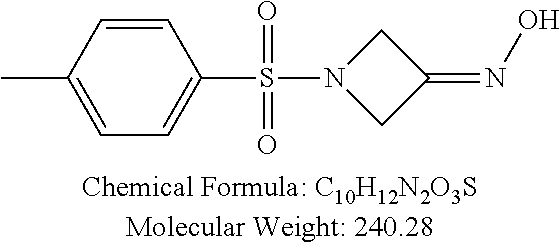
C00063

C00064
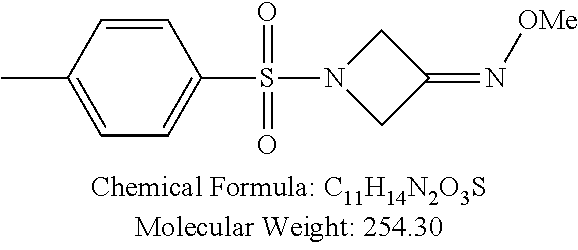
C00065

C00066
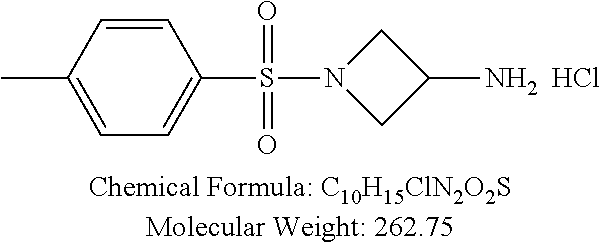
C00067

C00068

XML
uspto.report is an independent third-party trademark research tool that is not affiliated, endorsed, or sponsored by the United States Patent and Trademark Office (USPTO) or any other governmental organization. The information provided by uspto.report is based on publicly available data at the time of writing and is intended for informational purposes only.
While we strive to provide accurate and up-to-date information, we do not guarantee the accuracy, completeness, reliability, or suitability of the information displayed on this site. The use of this site is at your own risk. Any reliance you place on such information is therefore strictly at your own risk.
All official trademark data, including owner information, should be verified by visiting the official USPTO website at www.uspto.gov. This site is not intended to replace professional legal advice and should not be used as a substitute for consulting with a legal professional who is knowledgeable about trademark law.